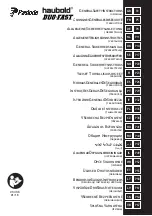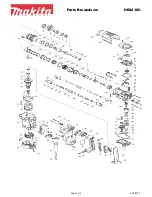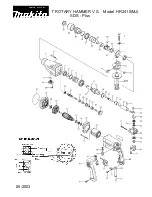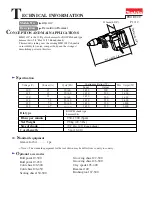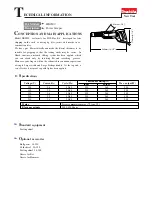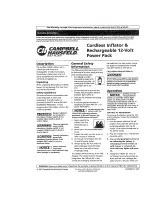
measures and increase the risks to the operator and/or
bystander.
An additional downforce is required to operate tools
which are used on hard surfaces, such as steel and
concrete, to prevent slipping.
Do not discard the safety instructions.
Do not use a tool if the tool has been damaged.
Be careful when handling fasteners, especially when
loading and unloading, as the fasteners have sharp
points which could cause injury.
Always check the tool before use for broken,
misconnected or worn parts.
Do not overreach. Only use in a safe working place. Keep
proper footing and balance at all times.
Keep bystanders away (when working in an area where
there is a likelihood of through traffic of people). Clearly
mark off your operating area.
Never point the tool at yourself or others.
If the operator has to move locations, the tool must be
carried pointed downwards.
Please keep the nailer out of the reach of children.
To warn that the tool has the capability of operating in
contact actuation mode.
Do not rest your finger on the trigger when picking up
the tool, moving between operating areas and positions
or walking, as resting finger on trigger can lead to
inadvertent operation. For tools with selective
actuation, always check the tool before use to ascertain
the correct mode is selected.
Only wear gloves that provide adequate feel and safe
control of triggers and any adjusting devices.
Always use the second handle (if supplied).
Projectile hazards:
The fastener driving tool shall be disconnected
(disconnect energy supply) when unloading fasteners,
making adjustments, clearing jams or changing
accessories or examination of the tool if misfires
During operation be careful that fasteners penetrate
material correctly and cannot be deflected /misfired
/broken out towards operator and /or any bystanders
Don’t shoot nail on nail.
During operation, debris from workpiece and fastening
/collation system may be discharged.
When using the tool, the operator and any bystanders
must wear appropriate eye protection (impact-resistant
eye protection with side shields).
The risks to others shall be assessed by the operator.
Ensure tool is always safely engaged on the workpiece
and can not slip.
Operating hazards:
Hold the tool correctly: be ready to counteract normal
or sudden movements such as recoil.
Maintain a balanced body position and secure footing
Only the main energy listed in the operating instructions
may be used.
Appropriate safety glasses shall be used and appropriate
protective clothing and gloves are recommended.
Appropriate hearing protection shall be worn .
Only wear gloves that provide adequate feel and safe
control of triggers and any adjusting devices.
Repetitive motions hazards:
If the operator experiences symptoms such as persistent
or recurring discomfort, pain, throbbing, aching,
tingling, numbness, burning sensation, or stiffness, do
not ignore these warning signs. The operator should
consult a qualified health professional regarding overall
activities.
Accessory and consumable hazards:
Only
use Paslode/haubold/Duo-Fast specified
consumables
or compatibles. In accordance with
(1 ,62
, Paslode/haubold/Duo-Fast has
specified, in its operating instructions, Paslode/
haubold/Duo-Fast consumables as safe to use. In
case of use of non-specified consumables, ensure
that they are compatible, safe and lawfully on sale in
European Union.
Only consumables and accessories listed in the operating
instructions may be used in the driving tools.
Only use the sizes and types of accessories that
are provided by the manufacturer.
Only use the lubricants listed in the operating
instructions may be used.
Disconnect the energy supply to the tool, such as air or
gas or battery as applicable, before changing /replacing
accessories such as workpiece contact, or making
any adjustments.
Workplace hazards:
Slips, trips and falls are major causes of
workplace injury. Be aware of slippery surfaces
caused by use of the tool.
Proceed with additional care in unfamiliar
surroundings. Hidden hazards may exist, such as
electricity or other utility lines.
Do not use the tool in potentially explosive atmospheres
the tool is not insulated from coming into contact with
electric power.
Make sure there are no electrical cables, gas pipes etc…
that could cause a hazard if damaged by use of the tool.
Dust and exhaust hazards:
Direct the exhaust so as to minimize disturbance of dust
in a dust filled environment.
Where dust or exhaust hazards are created, the priority
shall be to control them at the point of emission.
Noise hazards:
Unprotected exposure to high noise levels can cause
permanent, disabling, hearing loss and other problems
such as tinnitus (ringing, buzzing, whistling or
humming in the ears).
Appropriate controls to reduce the risk may include
actions such as damping materials to prevent workpieces
from “ringing”.
Use appropriate hearing protection.
Operate and maintain the tool as recommended in these
instructions, to prevent an unnecessary increase in
noise levels.
If the tool has a silencer, always ensure it is in place
and in good working order when the tool is being
operated. The values reported in the EC Declaration
are tool-related characteristic values and do not
represent the noise generation at the point of use.
Noise at the point of use will for example depend
on the working environment, the workpiece, the
workpiece support, and the number of driving
operations.
Vibration hazards:
Exposure to vibration can cause disabling damage to the
nerves and blood supply of the hands and arms.
Wear warm clothing when working in cold conditions,
keep your hands warm and dry.
If you experience numbness, tingling, pain or whitening
of the skin in your fingers or hands, seek medical advice
from a qualified occupational health
professional regarding overall activities.
3

